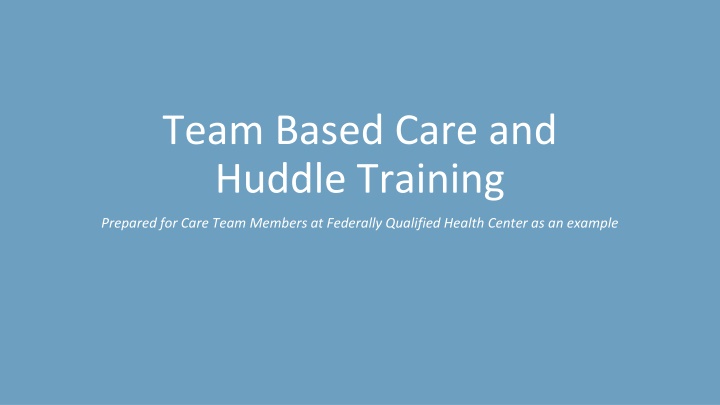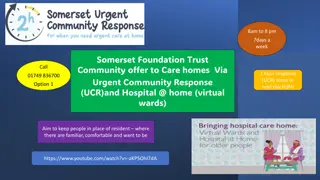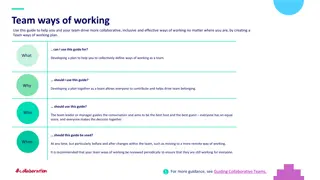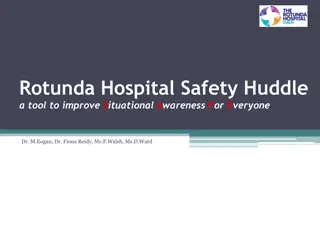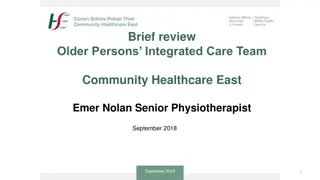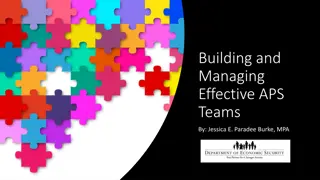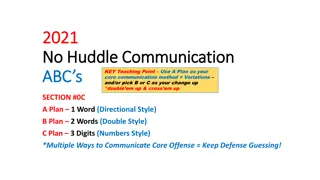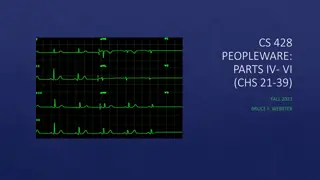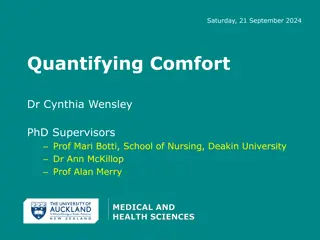Team-Based Care and Huddle Training for Healthcare Teams at FQHC
Understand the importance of team-based care and huddles in improving care coordination and efficiency at a Federally Qualified Health Center. Learn about the characteristics of effective huddles, ideal state of care teams, and competencies for enhancing patient care. Discover the building blocks of high-performing primary care and the tools for task distribution and data-driven improvement. Embrace the benefits of regular huddles in aligning healthcare teams for a productive day.
Download Presentation

Please find below an Image/Link to download the presentation.
The content on the website is provided AS IS for your information and personal use only. It may not be sold, licensed, or shared on other websites without obtaining consent from the author.If you encounter any issues during the download, it is possible that the publisher has removed the file from their server.
You are allowed to download the files provided on this website for personal or commercial use, subject to the condition that they are used lawfully. All files are the property of their respective owners.
The content on the website is provided AS IS for your information and personal use only. It may not be sold, licensed, or shared on other websites without obtaining consent from the author.
E N D
Presentation Transcript
Team Based Care and Huddle Training Prepared for Care Team Members at Federally Qualified Health Center as an example
Learning Objectives 1. Understand the importance of Team Based Care 2. Know how Huddles facilitate and improve Team Based Care 3. Recognize the characteristics of an effective Huddle 4. Be familiar with the Huddle Checklist and workflow at your health center
What is a Care Team? Ideal State: A clinical care team consists of the health professionals physicians, registered nurses, clinical pharmacists, and other healthcare professionals with the training and skills needed to provide high- quality, coordinated care specific to the patient s clinical needs and circumstances. Patient is the center the goal is for everyone to collaborate with each other.
What is a Huddle? A brief in person meeting of the patient care team to increase efficiency and access in the office setting Huddles provide an opportunity to anticipate patient needs and prepare for changes in staffing and logistics so the day runs more smoothly Typical length of huddles: 5-10 minutes Takes place daily at a regularly scheduled time, usually before the first patient of the day They can take place twice a day, if needed. One in the morning and one in the afternoon
The 10 Building Blocks of High Performing Primary Care Team based care is one of the foundational elements of the 10 Building Blocks of High Performing Primary Care Huddles are the first step in implementing and executing Team Based Care Prepared by Elevation Health Partners Slide 5 5/2/22
Competencies and Tools for Care Teams Task Distribution Based on Licensure & Ability Strategic Standing Orders Empathy, Bias and Humility Training Self-Management Support Data-Driven Improvement Community Partnerships Regular Huddles Pre-Visit Work Warm Handoffs Empanelment Care Coordination Uptalk Friday, April 28, 2023 Slide 6
Why Should We Huddle? Align the team at the start of the day/clinic session Allow for planning of the day, identifying spots for additional patient access Build team culture and improve communication for a more engaged workforce Prospectively plan for patients who require extra time and assistance Prepare for staff, provider, or equipment changes Aligns with PCMH
Establish the Routine for Huddles Involve the right people! Can be as simple as involving the provider and MA Including more team members can work as well, such as case managers, nursing supervisors, and front desk staff Schedule a time before the day starts Huddles should last around 5-10 minutes Start at a consistent time that can be integrated into the clinic s workflow smoothly Experimentation with time in the beginning may be necessary Determine a location for the huddle A convenient spot where everyone can easily meet and speak openly about patients: the nurse s station, a work room, etc. Whoever is leading the discussion should have access to a computer in case important patient information needs to be reviewed
Huddles have helped to eliminate these situations: Confusion about provider availability for scheduling Lack of awareness of broken equipment or unavailable labs Lack of preparation for scheduled patients who require extra time and assistance Staff shortages due to illnesses, vacations, and family emergencies Chaos due to last-minute schedule changes. Whether caused by patients, providers, office systems, or external factors Lack of awareness of how each person contributes to the practice's smooth functioning
1. Invite only the necessary people. Key participants are usually nurses, medical assistants, receptionists, and physicians. 2. Limit the huddle to seven minutes or less. Having everyone stand during the meeting will help keep it short and focused. 3. Have an agenda. The main purpose of the huddle is to check the schedule for potential slowdowns so you can proactively address them. For example, are there any patients who may require more time or assistance due to age, disability, etc.? Who can help? Are there any back-to-back lengthy appointments, such as physicals? Are there any openings that can be filled or chronic no-shows that can be anticipated? Which patients will need to have test results or notes from other physicians ready in the chart? Huddles: jump start your practice today
Develop Relationships and Designate Roles Use a checklist or template (see handout) Identify and define additional roles Designate a huddle leader Develop a strong team culture Many practices have found success in designating a nurse supervisor or MA to lead the huddle Some practices allow the leader to rotate between staff if multiple MAs or nurses are involved on the team; can lead to a strong culture of teamwork The leader role can evolve over time, and the leader should be sure to allow other team members the opportunity to speak up when necessary Implementing a huddle with the assistance of a checklist provides structure Helps keep conversations concise and focused The nurse manager or administrator can review staffing needs and absences for the day and reallocate as necessary Schedulers can note available clinic capacity that day and make the team aware of any same day openings and urgent or cancelled visits MAs can flag and preventive and chronic care needs Include a quick check-in at the beginning of the huddle to center the team and get everyone on the same page Share one positive story from the previous day about a staff member
Measuring the Impact of Huddles Possible metrics to track: Continuity of care Wait time Cycle time Patient satisfaction Provider satisfaction Clinical Quality Measures Use data and compare several months pre and post care team implementation
Daily Huddle Checklist at your health center
Azara PVP Example Alert Inconsistencies? Report them!
Huddle Workflow at Your Health Center Care Team Huddle with Provider and MA reviewing Huddle Checklist and Azara PVP Health Center director follows up with facilities, IT, or others as needed Site-Wide Huddle including Health Center Director and all staff MA s perform opening duties
